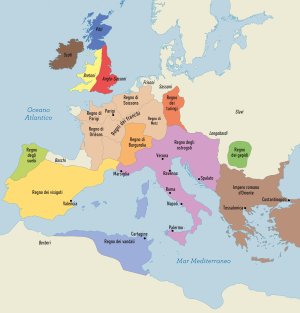Boris Gudenuf
Deity
Well, in truth, the Greeks and Romans had very complex relations and dealings with peoples they actually called, "Barbarians," like the Chinese did with peoples they called, "Yue," and Japanese with peoples they called, "Emishi," and, "Gaijan," and Aztecs with peoples they called, "Chichimeca," and Colonial- and Imperial-Era British with peoples they outright called, "Savages," (all terms used in roughly very similar context and usage to the Greco-Roman term, "Barbarian,"), and definitely were NOT as simple as, "hostile hordes at the foreign gates," - so a more interactive and detailed system is probably in order.
Yes, right now and forever in Civ the population has been divided into the people of the Civs, some ephemeral inhabitants of the 'goodie huts' , and infinite and forever Barbarians who have no other activity than to attack the Civs. This is both simple-minded and, frankly, insulting to the 'barbarians' - and it makes for a dull, predictable game.
IRL, the pastoral groups of Central Asia were always more interested in Trading than Raiding: the Long Wall (Great Wall) of China was, in fact, originally built not to keep the 'Northern Barbarians' out, but to control where they came in to trade, so the trade could be properly taxed by the Chinese government. The famous Scythian goldwork now gracing museums from New York to Saint Petersburg was mostly made by Greeks because the Scythians were really good customers and paid very well for such craftsmanship.
And the infamous Barbarian German tribes that supposedly constantly raided the Roman border? Not so much. In fact, a minor tribe called the Mattiachi, who lived right across the Rhine from Mantiacum (modern Mainz), the largest Roman military base north of Italy (2 full legions plus auxiliaries, making it by far the largest urban concentration of any kind north of Italy) invited Romans across the river, because they had a hot spring in the middle of their settlement, and basically set up a Tourist Trap to lure hot bath-loving Romans to come and take the waters - and trade. By 400 CE they were incorporated as a Roman town into the Empire - the newly-established Roman border that stretched around it in a wide arc is still marked by replica Roman mile forts in the Taunus Mountains to the north and east. Oh, and the Matti's original village is now the city of Wiesbaden - "Bath in the Meadow".
The relations between Non-Civ and Civ components of the population were much more complex than simple eternal enimity and should be much more complex in the game. This could be as simple as incorporating the Goodie Huts and Barbarian Camps into the same set of smaller settlements in the game, or it could involve a complex rendering of individual tribes, polities, nomads, city states, etc. But it needs to be something beyond the simplistic strife which is all we have now.
Last edited:


